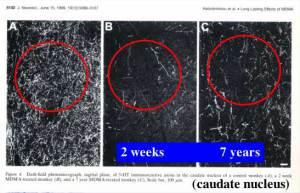
Toxicity and regrowth of serotonergic neurons after a single dose of MDMA in monkeys
The autism community is constantly bombarded with potential treatments, cures, and other claims for products that have no scientific evidence. Even worse, some of these products are known to be harmful and there have been reports of deaths after such treatments, like chelation. Unfortunately, another one of these non-evidence-based, potentially-harmful compounds, has made its way into the mainstream media, potentially confusing families and individuals with autism about the promise or potential of such treatments.
In March, investigators at the Los Angeles Biomedical Research Institute in California published the rationale and methodology for a new study investigating the effectiveness of MDMA or 3,4-methylenedioxymethamphetamine for the treatment of social anxiety in adults with autism.1 This drug has shown some promise for the treatment of post-traumatic-stress disorder. This recent publication, which presented no data, went mostly unnoticed or ignored in the scientific community until the mainstream media picked up on the idea and it has since ended up in the newsfeed. MDMA is the main ingredient in the drug commonly known as Ecstacy or Molly, which was added to the DEA Controlled Schedule list in 1985. The authors claim it is safer because in the pure form, it does not include any additives or fillers that may be included in the street form of the drug. However, this theory has a problem.
One important point that the authors of this publication completely failed to mention is the potent neurotoxicity of MDMA. This scientific fact is in stark contrast to the image the authors portray of it being a benign substance which opens the mind and promotes closeness. It is a form of amphetamine which has been proven to cause long lasting loss of neurons for serotonin in the cortex of animals exposed to MDMA2. As these animals age, some of the neurons start to grow back, but with shorter or absent dendritic spines3. In humans, MDMA exposure produces a similar pattern of neurotoxicity and leads to cognitive problems, sleep issues, and psychiatric issues.4-6 MDMA also induces an increase in body temperature, and has shown to be toxic on cardiac and liver tissues as well.7,8 According to scientific evidence ,therefore, a less-pure form of Ecstacy may actually be safer than the pure unaltered compound. Therefore, the claim that the version given in this study is ‘safer’ is misleading.
There is no known safe dose in humans. In fact, in non-human primates, one dose was sufficient to produce long lasting deficits in serotonergic functioning.9 Serotonin is associated with mood, emotion, and cognitive ability, so it is not really a surprise that MDMA use causes deficits in these areas of behavior. Consistent evidence using post-mortem brain tissue shows that people with autism have neurons that are already disorganized, misplaced, and irregularly shaped10. Therefore, giving this compound to individuals with ASD may be especially dangerous.
For those who were intrigued by this news story, concentrate on safe, non-toxic, evidence-based interventions. While the study received IRB approval, this is a dangerous compound that should be avoided. To see a comprehensive list of evidence and non-evidence based treatments, please go to our website. The autism community deserves better than to have money wasted on a study using a drug that is known to be toxic and in some cases, lethal.
- Danforth AL, Struble CM, Yazar-Klosinski B, Grob CS. MDMA-assisted therapy: A new treatment model for social anxiety in autistic adults. Progress in neuro-psychopharmacology & biological psychiatry. Mar 25 2015.
- Sarkar S, Schmued L. Neurotoxicity of ecstasy (MDMA): an overview. Current pharmaceutical biotechnology. Aug 2010;11(5):460-469.
- Williams MT, Skelton MR, Longacre ID, et al. Neuronal reorganization in adult rats neonatally exposed to (+/-)-3,4-methylenedioxymethamphetamine. Toxicology reports. 2014;1:699-706.
- Parrott AC. Human psychobiology of MDMA or ‘Ecstasy': an overview of 25 years of empirical research. Human psychopharmacology. Jul 2013;28(4):289-307.
- Benningfield MM, Cowan RL. Brain serotonin function in MDMA (ecstasy) users: evidence for persisting neurotoxicity. Neuropsychopharmacology : official publication of the American College of Neuropsychopharmacology. Jan 2013;38(1):253-255.
- Gerra G, Zaimovic A, Ferri M, et al. Long-lasting effects of (+/-)3,4-methylenedioxymethamphetamine (ecstasy) on serotonin system function in humans. Biological psychiatry. Jan 15 2000;47(2):127-136.
- Turillazzi E, Riezzo I, Neri M, Bello S, Fineschi V. MDMA toxicity and pathological consequences: a review about experimental data and autopsy findings. Current pharmaceutical biotechnology. Aug 2010;11(5):500-509.
- Baumann MH, Rothman RB. Neural and cardiac toxicities associated with 3,4-methylenedioxymethamphetamine (MDMA). International review of neurobiology. 2009;88:257-296.
- Mueller M, Yuan J, McCann UD, Hatzidimitriou G, Ricaurte GA. Single oral doses of (+/-) 3,4-methylenedioxymethamphetamine (‘Ecstasy’) produce lasting serotonergic deficits in non-human primates: relationship to plasma drug and metabolite concentrations. The international journal of neuropsychopharmacology / official scientific journal of the Collegium Internationale Neuropsychopharmacologicum. May 2013;16(4):791-801.
- Hutsler JJ, Zhang H. Increased dendritic spine densities on cortical projection neurons in autism spectrum disorders. Brain research. Jan 14 2010;1309:83-94.
